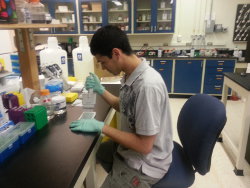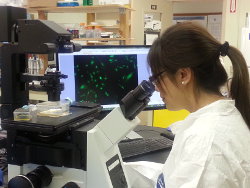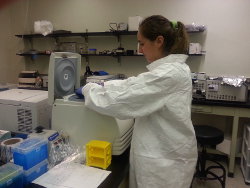Biomolecular and Biomimetic Material Research
The research in Dr. Yong Wang’s group focuses on creating programmable biomaterials for the purposes of controlled drug delivery, sensitive clinical diagnostics, and enhanced tissue regeneration. Current work in his lab is highlighted in three main projects: the creation of programmable hydrogels for protein drug delivery, the construction of a scaffold for the capture and controlled release of target cells, and the development of an artificial extracellular matrix for cell adhesion.
Programmable Protein Drug Delivery
 Many diseases can be treated using protein drugs (i.e. growth factors and antibodies). However, it is necessary to adjust the administration of these drugs over time to produce a therapeutic effect and avoid toxicity. The Wang group uses an aptamer-functionalized hydrogel platform to release multiple protein drugs on demand. Aptamers are short, single-stranded nucleic acid sequences with high affinity for specific targets. Using aptamers, protein drugs are sequestered within the hydrogel. At desired time points, complementary oligonucleotides are added to the system, competitively binding with aptamers and triggering the release of the protein drugs.
Many diseases can be treated using protein drugs (i.e. growth factors and antibodies). However, it is necessary to adjust the administration of these drugs over time to produce a therapeutic effect and avoid toxicity. The Wang group uses an aptamer-functionalized hydrogel platform to release multiple protein drugs on demand. Aptamers are short, single-stranded nucleic acid sequences with high affinity for specific targets. Using aptamers, protein drugs are sequestered within the hydrogel. At desired time points, complementary oligonucleotides are added to the system, competitively binding with aptamers and triggering the release of the protein drugs.
Controlled Cell Capture and Release
 The capture of target cells is important both for disease treatment and diagnostics. In this project, the Wang group uses an aptamer-functionalized hydrogel to capture target cell types with high specificity. Aptamers recognize target cells and induce their binding to the material. By adding a complementary trigger oligonucleotide, cells can be released on demand through the competitive binding of the trigger sequence with aptamer. Released cells can be further studied for future treatment strategies and diagnostics.
The capture of target cells is important both for disease treatment and diagnostics. In this project, the Wang group uses an aptamer-functionalized hydrogel to capture target cell types with high specificity. Aptamers recognize target cells and induce their binding to the material. By adding a complementary trigger oligonucleotide, cells can be released on demand through the competitive binding of the trigger sequence with aptamer. Released cells can be further studied for future treatment strategies and diagnostics.
Artificial Extracellular Matrix
 For regenerative medicine, it is both challenging and necessary to develop materials that closely mimic the complex environment of the extracellular matrix. These materials must have both physical and chemical properties that promote cell adhesion, growth, and proliferation. The work in the Wang group is focused on creating a hydrogel material that uses aptamers for cell adhesion without impacting the mechanical properties necessary for cell growth. Aptamers are incorporated into the hydrogel using free radical polymerization, proving cell-specific binding properties to the material. Cell adhesion is affected by aptamer concentration, spacer length, and cell seeding time.
For regenerative medicine, it is both challenging and necessary to develop materials that closely mimic the complex environment of the extracellular matrix. These materials must have both physical and chemical properties that promote cell adhesion, growth, and proliferation. The work in the Wang group is focused on creating a hydrogel material that uses aptamers for cell adhesion without impacting the mechanical properties necessary for cell growth. Aptamers are incorporated into the hydrogel using free radical polymerization, proving cell-specific binding properties to the material. Cell adhesion is affected by aptamer concentration, spacer length, and cell seeding time.
- Erin Richards, doctoral student in biomedical engineering

